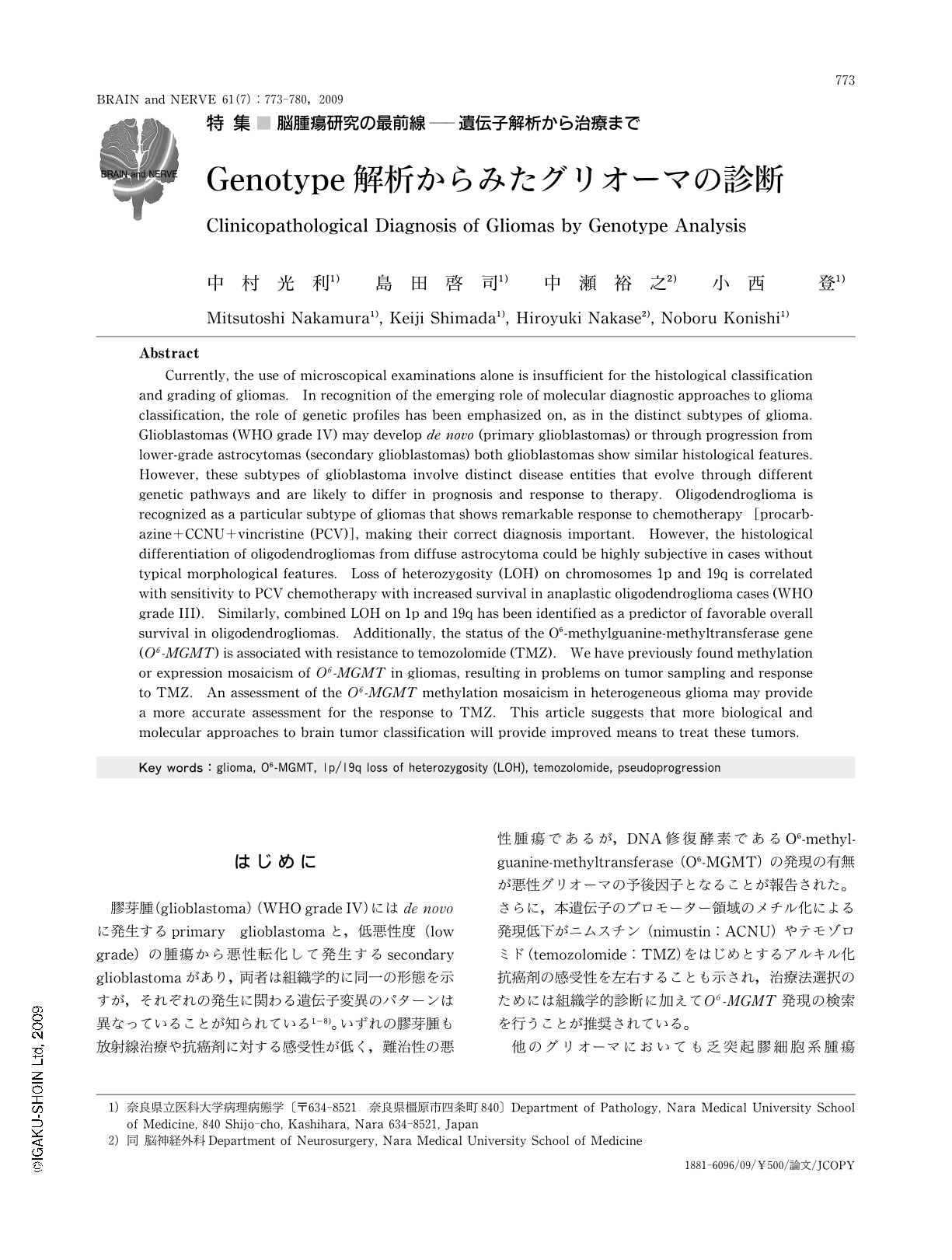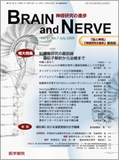Japanese
English
- 有料閲覧
- Abstract 文献概要
- 1ページ目 Look Inside
- 参考文献 Reference
はじめに
膠芽腫(glioblastoma)(WHO grade IV)にはde novoに発生するprimary glioblastomaと,低悪性度(low grade)の腫瘍から悪性転化して発生するsecondary glioblastomaがあり,両者は組織学的に同一の形態を示すが,それぞれの発生に関わる遺伝子変異のパターンは異なっていることが知られている1-8)。いずれの膠芽腫も放射線治療や抗癌剤に対する感受性が低く,難治性の悪性腫瘍であるが,DNA修復酵素であるO6-methylguanine-methyltransferase(O6-MGMT)の発現の有無が悪性グリオーマの予後因子となることが報告された。さらに,本遺伝子のプロモーター領域のメチル化による発現低下がニムスチン(nimustin:ACNU)やテモゾロミド(temozolomide:TMZ)をはじめとするアルキル化抗癌剤の感受性を左右することも示され,治療法選択のためには組織学的診断に加えてO6-MGMT発現の検索を行うことが推奨されている。
他のグリオーマにおいても乏突起膠細胞系腫瘍(oligodendroglial tumor:OT)は星細胞系腫瘍(astrocytic tumor:AT)に比べてプロカルバジン(procarbazine)+CCNU+ビンクリスチン(vincristine)(PCV療法)の感受性が高く,予後も良好であることが示され,両者の鑑別が重要となってきている9,10)。また,2007年改訂のWHO分類では組織診断名に対応してWHO gradeが決定されるため,退形成乏突起星細胞腫(anaplastic oligoastrocytoma:AOA)(WHO grade Ⅲ)とglioblastoma with oligodendroglioma(WHO grade Ⅳ)との鑑別など,OTあるいはATの明確な診断が要求される。しかし,組織形態学的に両構成成分は類似あるいは混在することが多く,両者の明確な診断基準も確定されていないため,病理組織診断が主観的となる症例も多い。
近年,OTでは1番染色体短腕(1p)と19番染色体長腕(19q)のloss of heterozygosity(LOH)がATに比べて高頻度で検出され,1p/19qのLOHが認められる症例は治療反応性がよいことが示されると,両染色体異常も精力的に検索されるようになってきた。
このように組織学的な鑑別が困難な症例や,治療法の選択には従来の組織形態学的な分類のみならず,遺伝子解析も含めた臨床病理学的な検討を行う必要があると考えられる。筆者らはグリオーマを中心とする種々の脳腫瘍における遺伝子変異を検索し,その臨床病理学的意義を明らかにすることで,診断・治療における遺伝子解析の有用性を検討してきた。本稿においては,グリオーマ治療法の選択に必要とされるgenotype解析からみた病理診断を自験例も交えながら概説したい。
Abstract
Currently,the use of microscopical examinations alone is insufficient for the histological classification and grading of gliomas. In recognition of the emerging role of molecular diagnostic approaches to glioma classification,the role of genetic profiles has been emphasized on,as in the distinct subtypes of glioma. Glioblastomas (WHO grade IV) may develop de novo (primary glioblastomas) or through progression from lower-grade astrocytomas (secondary glioblastomas) both glioblastomas show similar histological features. However,these subtypes of glioblastoma involve distinct disease entities that evolve through different genetic pathways and are likely to differ in prognosis and response to therapy. Oligodendroglioma is recognized as a particular subtype of gliomas that shows remarkable response to chemotherapy [procarbazine+CCNU+vincristine (PCV)],making their correct diagnosis important. However,the histological differentiation of oligodendrogliomas from diffuse astrocytoma could be highly subjective in cases without typical morphological features. Loss of heterozygosity (LOH) on chromosomes 1p and 19q is correlated with sensitivity to PCV chemotherapy with increased survival in anaplastic oligodendroglioma cases (WHO grade III). Similarly,combined LOH on 1p and 19q has been identified as a predictor of favorable overall survival in oligodendrogliomas. Additionally,the status of the O6-methylguanine-methyltransferase gene (O6-MGMT) is associated with resistance to temozolomide (TMZ). We have previously found methylation or expression mosaicism of O6-MGMT in gliomas,resulting in problems on tumor sampling and response to TMZ. An assessment of the O6-MGMT methylation mosaicism in heterogeneous glioma may provide a more accurate assessment for the response to TMZ. This article suggests that more biological and molecular approaches to brain tumor classification will provide improved means to treat these tumors.

Copyright © 2009, Igaku-Shoin Ltd. All rights reserved.


